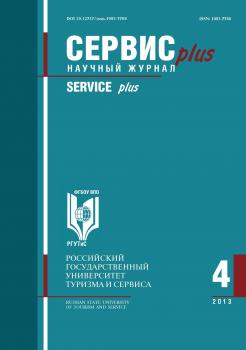The article puts forward the idea that visiting friends and relatives tourism (VFR tourism) is quite an attractive and promising kind of tourism in economic terms contrary to the common opinion about it being a minor and not profitable one owing to the fact that VFR trip makers spend less money than other types of tourists as they do not use local accommodation, restaurants, attractions and so on. Using the results of ample foreign research the authors claim that current VFR tourist expenditure appears to exceed (when the average host´s spending is added) that of tourists falling into other categories. A VFR tourist sufficiently often uses commercial accommodation facilities and prefers active pastime including dining, city sightseeing, visiting museums, theatres. The paper also identifies and systematizes the main characteristics of VFR tourism, which provides considerable economic benefits to the appropriate destination areas. Particular emphasis is put on creating jobs, a ´seasonal compensation´ to the temporal flow pattern, local revenue mobilization because of VFR trips repetition and regularity, as well as a popularization of destination through VFR tourists responses and word-of-mouth advertising. In reference to Russia, the authors substantiate the expediency of maintaining and developing the international segment of the VFR tourism market and the necessity for scientific research into the internal Russian VFR tourism market potential.
VFR tourism, private trips, VFR tourists, economic benefits
Туризм с целью посещения друзей и родственников вообще и как экономически выгодный для национальной и муниципальной экономик вид туризма попал в поле зрения ученых относительно недавно. Долгое время считалось, что по сравнению с другими категориями путешествующих посещающие друзей и родственников туристы (далее — ПДР туристы) совершают в ходе поездки меньше трат, ввиду отсутствия у них необходимости пользоваться коммерческими средствами размещения, а также неактивным посещением предприятий общественного питания, музеев, театров и т. д. Действительно, ряд ученых: Е. Денман [1], С. Ланглоис [2], А. Моррисон и его коллеги [3], А. Сиатон и С. Палмер [4] показали, что общая сумма расходов, осуществляемых туристами, посещающими друзей и родственников, ниже, чем у других категорий туристов. Однако более поздние исследования позволили опровергнуть данное утверждение. В частности, Д. Москардо, П. Пиаре, А. Моррисон, Д. Грин и Ж. О'Леари [5] аргументированно доказали, что часть туристов, посещающих друзей и родственников, предпочитает останавливаться в коммерческих средствах размещения. Согласно выводам К. Браунлича и Н. Надкарни [6], изучавшим частоту поездок туристов к друзьям и родственникам, проживающим в северо-восточной части центрального региона Соединенных Штатов Америки, более одной пятой всех туристов, входящих в данную категорию, останавливается в коммерческих средствах размещения.
В свою очередь, в работах Т. Юан, Ж. Фриджен, С. Хайс и Ж. О'Леари [7] было убедительно показано, что многие из тех туристов, которые определили главной целью своего путешествия посещение друзей и родственников, не замыкаются исключительно на социальных контактах с ними, а активно осматривают окрестности, местные достопримечательности, участвуют в культурно-массовых мероприятиях, расходуя финансовые средства. Показательны в этом плане результаты сегментирования рынка ПДР туризма в Квинсленде, осуществленного А. Моррисо-ном и его коллегами [8]. Ими были определены 26 видов деятельности, в которых участвовали опрошенные в рамках исследования ПДР туристы, и на основании кластерного анализа выделены 4 группы различающихся по своим характеристикам туристов, посещающих своих друзей и родственников. В первую группу они
1. Denman, E. (1988) Aresponse to the VFR market. A report to the English Tourist Board and Regional Tourist Boards. London: British Tourist Authority/English Tourist Board.
2. Langlois S.M., Theodore J., Ineson M. (1999) Poland: in-bound tourism from the UK. Tourism Management 20: pp. 461-469.
3. Morrison, A.M., Verginis, C, O´Leary, J.T. (2000) Reaching the Unwanted and Unreachable: An Analysis of the Outbound, Long Haul German and British Visiting Friends and Relatives Market. Journal of Tourism and Hospitality Research, 2 (3): PP. 241-231.
4. Seaton, A. V., Palmer, C. (1997) Understanding VFR Tourism Behavior: The First Five Years of the United Kingdom Tourism Survey. Tourism management (18(6): PP. 345-355.
5. Moscardo, G., Pearce, P., Morrison, A., Green, D., O´Leary, J. (2000). Developing a Typology for Understanding Visiting Friends and Relatives Markets, Journal of Travel Research, 38: PP. 251-259.
6. Braunlich, C.G., Nadkarni, N. (1995). The importance of the VFR market to the hotel industry. The Journal of Tourism studies vol.6, No. 1, May 95: PP. 38-47.
7. Yuan, T, Frigden, J., Hseih, S.,0´Leary, J. (1995). Visiting Friends and Relatives: The Dutch Case. The Journal of Tourism Studies, 6 (1): PP. 19-26.
8. Morrison, A.M., Hsieh, S., O´Leary J.T. (1995). Segmenting the Visiting Friends and Relatives Market By Holiday Activity Participation. The journal of tourism studies Vol. 6, No. 1, MAY: 51.
9. Lee, G., Morrison, A.A., Lheto, X. Y., Webb, J., Reid, J. VFR: Is it really marginal? A financial consideration of French overseas travellers. Journal of Vacation Marketing 2005 11: P. 342.
10. Backer, E. Current issues in tourism: VFR travel: an expenditures of VFR travellers and their host: P. 374.
11. Meis, S., Joyal, S., Trite, A. (1995). The US repeat and VFR visitor to Canada: Come again, Eh! Journal of tourism studies, 6(1): PP. 27-37.
12. Quotations from: Asiedu, A.B. Participants´ Characteristics and Economic Benefits of Visiting Friends and Relatives (VFR) Tourism - an International Survey of the Literature with Implications for Ghana. International journal of tourism research Int. J. Tourism Res. 10, 2008: P. 615.
13. King, B. (1996). VFR - A Future Research Agenda. In H. Yaman (Ed.). VFR Tourism: Issues and Implications. Proceedings from the Conference held at Victoria University Conference, Victoria, Australia: PP. 85-89.
14. Letho, X.Y., Morrison, A. M., O´Leary,!. T. (2001). Does the visiting friends and relatives typology make a difference? A study of the International VFR market to the United States. Journal of Travel Research 40: PP. 202.
15. MacEachern, M. (2007). Characteristics of the Visiting Friends and Relatives Markets in Prince Edward Island: A Longitudinal Approach, 2007 TTRA Annual Conference Proceedings: P. 200.
16. Ни, Bo A., Morrison A.M., O´Leary J.T. (2002). An Analysis of the Variety-Seeking Behaviour of the U. S: Visiting Friends and Relatives Market. The journal of tourism studies Vol. 13, No. 2, DEC. ´02: P. 38.
17. Gurry, S. (2005). First Time and Repeat Visitors to the UK, 2001 and 2004. VisitBritain. Available at http:// www. Tourismtrade.org.uk/images/repearters04_teml2-12495.pdf
18. Backer, E, Lynch, D. (2009). VFR Travel Research Project. City of Ballarat, University of Ballarat: P. 20.
19. National survey of the Vermont visitor: an examination of the visiting friends and relatives Tom Noordewier, School of Business Administration and Vermont 2001. https://www.google.ru/search?q=+++NATIONAL+SU RVEY+OF+THE++VERMONT+\TSITOR:++AN+EXAMINATION+OF+THE+VISITING++FRIEND S+AND+RELATTVES%E2%80%99+%28VFR%29+TRAVELER&ie=utf-8&oe=utf-8&rls=org.mozilla:en-US:ofncial&client=firefox-a&gws_rd=cr. Accessed on September 27, 2013.
20. UNWTO Tourism highlights 2013 Edition. Retrieved http://dtxtq4w60xqpw.cloudfront.net/sites/all/ffles/pdf/ unwto_highlightsl3_en_hr_0.pdf Accessed on September 24, 2013.
21. Chislo poezdok inostrannykh grazhdan v Rossiiu po (tseliam poezdki) [Russia-bound tourist index: by the number of trips]. http://www.gks.ru/dbscripts/cbsd/dbinet.cgi. Accessed on September 25, 2013.
22. Shcherbakova, E. Demograficheskie itogi 2012 goda (chasf III) [2012 Demographic statistics. Part III]. Rossiiskii demograficheskii barometr [Russian demographic barometer]. 2013. № 545-546. March 4-17. http://www. demoscope.ru/weekly/2013/0545/barom01.php. Accessed on Septemer 24, 2013.
23. Faktory, obuslavlivaiushchie sostiianie VFR turizma [Factors determining the state of VFR tourism]. Universitetskie chteniia 2013. Materialy nauchno-metodicheskikh chtenii PGLU. Chasf XVIII [University readings. Proceedings of the research and methodological readings (PSLU). Part XVIII]. Pyatigorsk: PSLU Publ, 2013. pp. 108-112.

















